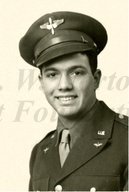
|

|
|
|
|
He was born in Flatwoods, Louisiana, the youngest of three children of Mitchell C. Watkins and Hettie Elizabeth Martin. His father was a farmer and school bus driver who also sold Watkins Products. Marvin picked cotton as a boy and wore to school shirts his mother made from flour sacks. His family later moved to Natchitoches where he graduated from Natchitoches High School in 1943. Marvin recalls long lines at recruitment stations after the Japanese attacked Pearl Harbor. He estimates that a fourth of his high school class joined the armed forces. Marvin finished high school at 17, knowing he would eventually go into the service. Meanwhile, Magnolia Petroleum Company employed him as a truck driver, a position that carried a deferment from military duty. Wanting to serve, however, he hitchhiked to Shreveport and joined the U.S. Army Air Forces. After basic training at Sheppard Field in Wichita Falls, Texas, he was tapped to attend B-24 gunnery school in Harlingen, Texas. There he was trained as a nose turret gunner in a B-24. On June 3, 1944 he left from Camp Miles Standish in a large convoy of ships bound for Liverpool, England, and stationed at a base near Lytham, England, where planes were repaired. Marvin went up in them to test the weaponry. He was soon to enter another branch of service, however. During the Battle of the Bulge, when reinforcements were desperately needed, Marvin was transferred into the infantry. After infantry training at Severn, England, he was assigned as a weapons squad leader Easy Company, 2nd Battalion, 24th Regiment, 44th Infantry Division, 3rd Army. His squad carried 60-millimeter mortars and two, 30-millimeter machine guns (check this). Marvin arrived in Belgium soon after Christmas, when his division was taking over for the 96th Division. As he fought across Belgium and into Germany near war's end, Marvin saw horses pulling German artillery, with older men and young boys filling the enemy ranks. He helped liberate Dachau, one of the major concentration camps, in an episode he recalls as "the most terrible thing I'd ever seen in my life." He also remembers seeing General George S. Patton, Jr., commander of 3rd Army, three times, and describes him as the one "who did more to win the war quickly than any other general we had." Marvin was proud to be an infantryman. "If you lived through it you were proud that you were there. You can say you were there at the war; you weren't somewhere else. And after the war was over, you were really proud. And then, let me tell you, you put on that blue braid and wear that combat infantry badge in Paris, and those Air Corps boys would get off the sidewalk for you. It made a difference. They respected you." After Germany surrendered he was placed in an ordnance unit in Nuremberg. Soon, however, that unit was sent to a large assembly area in France called Camp New Orleans to await transfer to the Pacific Theater. Not having enough points to go home, he was sent back to Germany where he served as a sergeant of the guards at the Nuremberg War Criminal Trials. In all, he spent 19 months overseas. He sailed to New York on "20th or 23rd" of December on the William and Mary, a Victory ship. He reached home in early January, 1946. After enjoying a leave, he reported to Aberdeen Proving Grounds in Maryland where he served as a basic training instructor. He then worked as a shipping clerk. In May, 1946 he finished his service, then returned to Natchitoches where he joined the Army National Guard. He would serve in the guard for 21 years. On September 12, 1946 he married Gloria McDonald. They would have one child and one grandchild. Meanwhile, he entered Northwestern State College on the GI Bill, while working nights at the post office. He began selling life insurance for Woodmen of the World, and became the company's first million dollar producer. His career would take him to national field manager of the company, and residence in Omaha, Nebraska, for 16 years. In 1981 he and Gloria moved back to Shreveport. |


